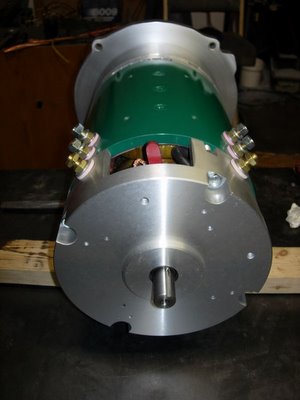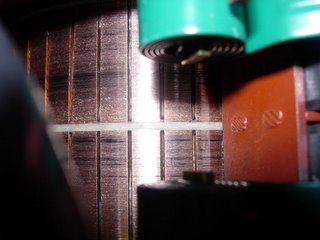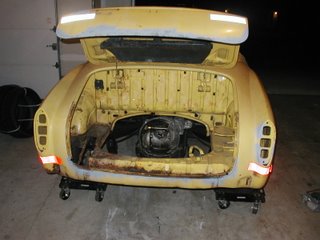A clutch in a pinch?

Now that the Gamera is ready for action, it comes time to finally install the taperlock hub, lightened flywheel, clutch, and pressure plate. So, with great enthusiasm and confidence I put on the hub and then the flywheel, being careful to properly position the hub on the shaft as close in as I dare, and to slowly tighten the allen screws in a crosswise pattern. Besides, taperlock hubs are self-centering by their very nature, right?

 Beautiful as it may be, when the above assembly was test-spun, it wobbled like a wounded duck, so this midnight escapade ends with Gamera back on the bench, the Bentley shop manual open for study, and Bug Me Video awaiting a less bleary-eyed mechanic.
Beautiful as it may be, when the above assembly was test-spun, it wobbled like a wounded duck, so this midnight escapade ends with Gamera back on the bench, the Bentley shop manual open for study, and Bug Me Video awaiting a less bleary-eyed mechanic.7/1 Update- With the sage advice of Jerry at Autosport International, (and the use of his air wrench) I was able to get the flywheel mounted true. Turns out that the winning technique involved remounting it a couple of times, rotating the hub 90 degrees each time, until I found the 'sweet spot' where the respective idiosynchracies were cancelled out (down to 0.002").
7/2 Update- But of course, solving one problem only leaves one free to find another. I've a nice stash of parts to pull from, like any aircooled enthusiast, but not the experienced eye to tell early from late clutch parts, especially with some racing and one-off versions thrown in for good measure. So, two motor installations later, I've got one mangled pressure plate, a scarred guide cone, and a non-functional clutch.. Time to go to the guru again. Besides, I need a bowden tube before that clutch will engage smoothly, even if I manage to escape without buying another throwout bearing, pressure plate, or clutch disk..

 When we last saw the Gamera Nine motor, it was winging it's way back to Jim Husted's custom motor shop on the Wayland Express: a free motor delivery service courtesy of Plasma Boy's good graces. Note to self- when taking advantage of the generous services of a fellow finickey hobbyist, make sure to brief him on any pre-existing conditions present on the package. You see, I forgot to tell John that I had put a nasty scratch in the motor's fresh finish when my jack slipped during a test installation. When Plasma Boy noticed this mark a day later, he about let his own smoke out, and confessed his apparent crime to Jim, who knew about the scratch and had a good laugh at John's expense! John, I owe you one.
When we last saw the Gamera Nine motor, it was winging it's way back to Jim Husted's custom motor shop on the Wayland Express: a free motor delivery service courtesy of Plasma Boy's good graces. Note to self- when taking advantage of the generous services of a fellow finickey hobbyist, make sure to brief him on any pre-existing conditions present on the package. You see, I forgot to tell John that I had put a nasty scratch in the motor's fresh finish when my jack slipped during a test installation. When Plasma Boy noticed this mark a day later, he about let his own smoke out, and confessed his apparent crime to Jim, who knew about the scratch and had a good laugh at John's expense! John, I owe you one.


















